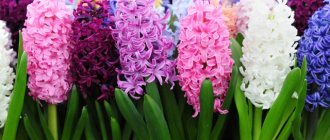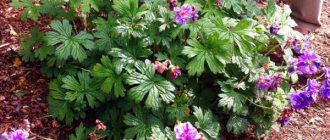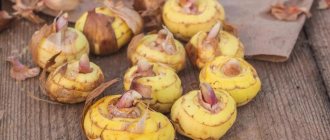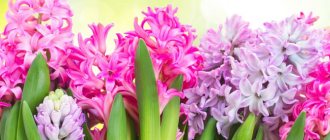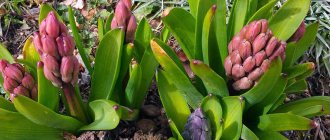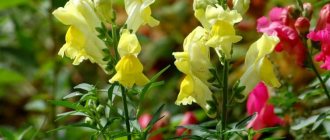Fuchsia is usually grown as a houseplant, but the flower looks no less elegant and beautiful in the garden. In landscape design, it can serve as an ampel flower, an accent or group plant in open ground, and can also be used in mixborders. Cultivation and care in the garden are somewhat different from the requirements of indoor agricultural technology, so a situation often arises when a flower slowly loses its decorative effect during garden cultivation. To prevent this from happening, you should familiarize yourself with the rules of care in open ground conditions.
Description of garden perennial fuchsia
Fuchsia owes its name to the German doctor L. von Fuchs, considered the “father of botany.”
Fuchsia branches are distinguished by their flexibility and downward direction of the crown.
What does a flower look like
The leaves have a bright green color and an oval shape. Their length is approximately 5 cm. The ends are pointed, and the edges of the leaves have a jagged border. The stems have a light reddish color. Sometimes the foliage also takes on this shade.
The flowers of the plant are single, directed downwards. They are shaped like a bowl. Flowers are double, simple and semi-double. Their color varies: there is orange, lilac, cream, white, pink, blue and violet.
Double flowers
Flowering continues for a long period of time. At this time, the flowers rush downwards more and more and fade towards the end of flowering.
Fuchsia is an annual or perennial plant
Fuchsia belongs to the genus of exotic perennial plants. But since this is a heat-loving flower, it is classified as an annual in northern latitudes.
Description of semi-ampel varieties
The peculiarity of semi-ampel varieties is that they change their shape as they grow . At the beginning of their life, these are semi-shrub forms with fairly strong shoots, but with age the stems become softer, and heavy flowers cause them to droop and droop.
Advice! Semi-ampelic varieties can be grown both in summer cottages, tying them to supports, and as indoor plants in pots with supports or in pots as ampelous ones.
It should be noted that due to the weakness of the shoots, it is always advisable to tie the plant to a support (for a hanging plant pot, this can be a rope to which the structure is attached). When there is abundant flowering, it is important to remove faded flowers in a timely manner. And it is also permissible to remove some buds so that numerous flowers do not break the branches.
Fairy
Fairy is a very beautiful semi-ampelic variety. The flowers are two-colored - a purple bud and a white or red skirt. The contrast of red or white and purple creates an unusual look that will decorate a balcony or room. The stems do not hold support well, so it is best to grow them as hanging varieties. It is very important to remove excess flowers in a timely manner so that the stems do not break.
Golden Monique
The most striking representative of semi-ampel varieties. It is distinguished by large double pink flowers. The skirt of the flower is usually colored in lighter shades than the sepals.
The leaves have a golden color, which is why the variety got its name. When there is insufficient lighting they turn green. The plant is very sensitive to sunlight and loves its abundance.
La fiesta
Unlike other plants of this variety, Fuchsia La Fiesta has white sepals rather than a skirt. At the same time, the skirt of the flower is bright crimson, very fluffy, decorated with white feathers. The variety is distinguished by abundant flowering and a large number of shoots . You can tie it to give the shape of the bush, but this is not always effective. It is advisable to ensure that the flowering is not too abundant and that the flowers do not break the shoots.
Planting fuchsia
There are many hybrid varieties that are quite frost-resistant, but for the most part fuchsias are heat-loving plants. In the garden, windless corners with sufficient lighting or slightly shaded are perfect for her. Prefers neutral, fertile soils.
Fuchsias are planted in open ground at the end of May - June. When planting, make sure that the root collar is buried no more than 20 cm. After rooting, the plants intensively gain strength and begin to bloom (about 2.5 weeks). Before being dug up for the winter, the plant must survive the first frost, thus undergoing some hardening before winter dormancy.
Botanical description
Fuchsia is a genus of woody perennials from the fireweed family, which includes about 100 species. Comes from the humid tropics and subtropics of Central and South America, Tahiti, New Zealand.
Appearance
In their homeland, fuchsias are mostly evergreens. In Russia they behave like deciduous perennial trees or shrubs.
The leaves of the crop are collected in whorls of 3-5 pieces or opposite. The length ranges from 1 to 25 cm, but usually within 4-5 cm. The plates are simple, pointed, with a finely toothed edge, elongated oval in shape. The color is green or reddish, there are variegated varieties.
Fuchsia shoots can be relatively flexible and thin, or rigid and erect. The vast majority of cultivars have untrimmed stems that are something in between. Over time, the branches become woody and covered with beige bark.
Bloom
Fuchsia buds form at the tips of the current year's shoots. Flowers consist of two parts, the color of which can be the same, different or differ in shade:
- The calyx is 4 lanceolate, with pointed tips of the lobes, fused at the base into a long tube. After the fuchsia buds have fully bloomed, they are located perpendicular to the petals or slightly cover the base of the corolla, but more often they are bent back to varying degrees. In the latter case, the sepals can be straight, curved, like a bow string, or even slightly twisted. Color: white, all shades of pink or red.
- The fuchsia corolla is often much shorter than the sepals, simple, with 4-5 petals, or terry, looking like a fluffy skirt. The color of the corolla can be white, different shades of pink, red, blue, light blue, violet. Sometimes the petals are painted with contrasting streaks or strokes.
Fuchsias can also be distinguished by their long anthers and pistil protruding beyond the corolla. In ampelous varieties, the buds are attached to a long drooping pedicel and range in size from 1 to 10 cm.
Under natural conditions, the crop is pollinated by hummingbirds. After fertilization, dark purple berries measuring 5-25 mm are set. In most species they are edible and taste like a mixture of citrus and black pepper.
Is it possible to plant fuchsia in open ground?
Fuchsia is grown as an outdoor flower not only in hanging baskets, stationary flowerpots, but also in flower beds. True, in all regions in the fall the bushes will have to be dug up from open ground and brought indoors.
Culture loves fresh air. If you choose the right planting location, fuchsia grows faster outdoors and blooms more profusely than at home.
Almost all species, varieties and hybrids feel better in the middle zone than in the south. In cool climates, bushes suffer less from heat in summer - despite the fact that the plant is tropical, it does not like high temperatures.
Most common varieties
Many modern varieties are characterized by bright color combinations.
Fuchsia Blue Vale
This is a universal variety; it can be grown either as a bush or as an ampel. The snow-white sepals of double, large flowers have a green tint along the edge. The flower's skirt is fluffy and lavender in color.
Flowering is long lasting and very abundant.
Fuchsia Bella Rosella
The plant has some of the largest flowers (10-12 cm). They are terry, bright, lilac-pink with snow-white stamens and pale pink sepals. Flowering is abundant and long lasting.
Fuchsia variety Bella Rosella has an ampelous and bush form. It is unpretentious and can grow in shade.
Variety Bella Rosella
Fuchsia Blue Angel
Blue Angel variety is an exquisite, memorable fuchsia. The flower size is up to 12 cm in diameter. The corolla (skirt) of the flower is double dark lilac in color, the sepals are white. When fully bloomed, white stamens with pink anthers become a spectacular accent. The bush is semi-ampelous (drooping).
Fuchsia Hollis Beauty
The flowers are large (7-8 cm), double, white sepals, lilac-blue skirt. The bush grows very neatly, has a compact shape, and branches well. The variety tolerates heat and bright sun better than other fuchsias.
The flower is elegant, contrasting, white-green sepals set off the purple-pink skirt. Especially good in full dissolution. Pink elongated stamens set off milky white anthers.
Important ! The growing form is ampelous; the lashes of an adult plant grow up to 60 cm in length.
Fuchsia Blue Ice
The plant was obtained as a result of the starting mutation of the Dark Eyes variety in 1954 in the United States of America. Large, double flowers are distinguished by a characteristic arrangement of petals. They resemble a multi-layered petticoat. The color of the petals is deep lavender, the sepals are light crimson. It is interesting that in plants of this variety, flower petals can vary in color intensity. The variety is undemanding; it is grown in bush and hanging forms. Grows quickly, restrictive pruning is recommended to form a dense crown. Feels good in partial shade.
Fuchsia Bicentennial
Fuchsia ampelous Bicentennial is painted in salmon-orange tones. The characteristic magenta strokes along the edge of the multi-layered skirt create an extraordinary color contrast. The flowers are elongated, rather large, in the form of buds. Light sepals become bright orange over time.
The variety was bred by Californian gardener Ted Pasquesen in 1976 and dedicated to the 200th anniversary of US independence. Paskesen carried out lengthy breeding work to obtain a variety that was resistant to heat and strong winds.
The plant forms a dense, branching crown and blooms profusely.
Variety Blue Mirage
Fuchsia Blue Mirage
The plant can be grown as a semi-mounted plant, in the form of a drooping bush and in hanging containers.
Blue Mirage is a large-flowered variety that blooms with deep purple flowers with snow-white sepals. The length of the shoots of the variety is up to 40 cm. Flowering is early, abundant, and long-lasting. The flowers are double and large.
The leaves are medium in size, the stems become woody quickly, so the variety is easy to grow in standard form. The variety is fast growing and winters well. Suitable for growing by beginning gardeners.
Fuchsia propagation
1. Seeds
- used if desired to experiment with selection. Plants grown from seeds may lose their parental varietal qualities, and there is more hassle. But if you decide to grow fuchsia from seeds, plant them in containers in March-April, lightly sprinkling them, or even better, use peat tablets for planting, which can then be immediately replanted without disturbing the root system of the plant. After planting, keep the containers at a temperature of 16-18 ° C; the seeds will germinate in about 3 weeks.
2.
Vegetatively
— as a rule, cuttings are used. To do this, choose slightly woody shoots that are rooted in water or a liquid substrate or sand. Roots will appear within 1-2 weeks. Bush and ampelous plants take cuttings every three years, thus renewing the plant. Three-leaved fuchsia is also propagated by cuttings, which results in abundant flowering.
Reproduction
For propagation, one of the possible methods is used: seed or vegetative. Old copies will have to be updated in any case, since after three years they lose their decorative effect. This applies to a greater extent to ampelous varieties, which become bare earlier than others.
Seeds
To get a specific variety, you will have to purchase seeds at a flower shop, since those collected from old plants will not give varietal characteristics. Growing seedlings is quite simple and can be easily done at home. First of all, pay attention to the variety being intended for growing in the garden.
Sowing is carried out at the end of March or beginning of April, after pre-treating the seeds with a weak solution of fungicide. Planting material can be sown in soaked peat tablets or in soil for growing seedlings. It is necessary to create greenhouse conditions, for which a film shelter is made. The temperature for normal germination of seedlings should not fall below 17°C.
After about three weeks, new shoots will appear. Their cultivation involves daily ventilation, removing condensation from the film and spraying with a spray bottle. As the seedlings grow, they are thinned out so that they do not interfere with each other's growth. The strongest and healthiest specimens should be left.
By cuttings
The most common method of propagating fuchsia. To do this, you will need to cut slightly woody shoots 10-15 cm long from an old bush. There should be no signs of disease or dark spots on the cuttings.
For rooting, the cuttings are placed in sand or water, having first removed the lower leaves. Sometimes peat tablets are used for rooting. The first roots appear after a couple of weeks, after which the branch begins to actively grow. During rooting, the cuttings are placed in a warm place with a temperature of about 18-20°C. When the roots grow to 3-5 cm, young specimens can be planted in a permanent place in the garden.
Storing fuchsia in winter
Usually, before the onset of real cold weather, plants are dug up, previously cut to half.
They are usually placed in a container, close to each other. Ensuring rest comes down to reducing watering to once a week and keeping the plants at a temperature not exceeding 10 ° C so that the fuchsia does not start to grow. After the leaves fall, the fuchsia can be removed to a dark room with watering once a month. My fuchsia overwintered in an unheated bathhouse in a container mixed with sand and earth in a tin bucket, covered with old cotton blankets. And she survived the winter! This indicates good endurance, but still it is not worth taking unnecessary risks; it is better to ensure constant temperature conditions.
Starting in March, we bring fuchsia back to life. To do this, we cut its shoots to 15 cm and replant them in a new nutrient soil mixture, increasing watering.
Reproduction methods
Like most plants, fuchsia reproduces in two main ways - vegetatively and seeds. It is better to take cuttings for propagation before pinching the plant.
Cuttings
Cuttings allow you to get a guaranteed result in a fairly short time. For cuttings, shoots and leaves with buds are used. Plants are kept at room temperature and watered regularly. The time for cuttings is the beginning of summer or the end of spring, but you can do this at any time except winter.
Why doesn't fuchsia bloom?
Why fuchsia doesn’t bloom, what to do, how to care for fuchsia
A healthy plant may refuse to bloom, and then you need to look for the reasons for this phenomenon. They may be different, but the root is the same - improper care. The main problems are as follows:
- the plant overwintered in a warm place;
- there are practically no useful substances left in the soil;
- very frequent watering;
- the pot is of the wrong size;
- there is very little light, the lack of which inhibits active growth and bud formation.
To ensure fuchsia flowering, these problems must be eliminated. If the wintering was warm, after it the shoots are severely pruned. If the pot is unsuitable, organize a flower transplant. The roots should not protrude from the pot and should not feel too open, otherwise the fuchsia will begin to form green shoots and will not bloom.
Diseases and pests
The flower has fairly good immunity, but there are hardly any pests that can cause problems for gardeners:
- Whitefly is a small insect that often infects plants located on balconies. The main symptom is a whitish coating on the leaves. When severely damaged, they turn yellow and fall off. You can cure it by washing it with soap and water, but this will only help if the fuchsia is still green. If the damage has progressed further, then only chemical treatment with special preparations will cope.
- Spider mites - attack the plant in dry and warm air. A sign of infection is yellowness on the leaf and a yellowish-gray coating on the underside. To prevent infection by this pest in hot weather, you should spray the plant regularly.
Other diseases are most often caused by improper care and inadequate nutrition. Thus, when the soil is excessively moistened, powdery mildew appears, and when manganese is deficient, leaf veins turn yellow.
Proper cultivation and care of fuchsia in the garden
Fuchsia belongs to the genus Fireweed perennial plants. It is an unpretentious flower that grows both at home and in the garden.
This plant is remembered for its spectacular flowering, unlike any other flower. Another name for fuchsia is “Japanese lantern”, as flower growers call it because of the unusual shape of the buds. Read more about growing and caring for beautiful and unpretentious fuchsia in our article.
Fuchsia seeds
Grains for planting can be purchased at a specialty store. Many gardeners prefer to select plants online and make payments upon receipt. The grains must be fresh. They should be selected depending on the type of fuchsia and personal preferences.
Beautiful fuchsia flower
Important! When a plant is propagated by seeds, the risk of loss of varietal characteristics increases. If the gardener has an adult fuchsia, then you can pollinate it artificially and collect boxes with grains in place of wilted inflorescences
Using several varieties for this procedure allows you to grow a plant with a unique color
If the gardener has an adult fuchsia, then you can pollinate it artificially and collect boxes with grains in place of wilted inflorescences. Using several varieties for this procedure allows you to grow a plant with a unique color.
What do fuchsia seeds look like?
Fuchsia seeds are obtained from the fruit that forms during flowering. They are light brown in color and small in size. The achenes are similar in shape to garlic cloves. Most often in the store you can find such varieties as Bella Rosella, Holiday, Foxtrot. Planting and care are carried out depending on the plant variety. The packaging usually contains step-by-step instructions on how to sow and care for seedlings.
Fuchsia seeds
Wintering fuchsia in open ground
Fuchsia Magellanica feels great under the snow, covered with spruce branches; for other species and resistant hybrids, it is still worth taking a number of necessary measures.
Before the onset of cold weather, we cut our beauty at ground level, sprinkle it with a layer of at least 20 cm of soil, cover it with spruce branches and isolate it from excess moisture, placing another film or roofing material on top. In mid-May, the plant begins to open. From mid-June, growth from the root collar will begin to appear, and only in August will fuchsia begin to bloom.
Many gardeners do it even simpler, rooting new cuttings every year without leaving the plants in the fall. In this case, the cuttings will show miracles of flowering all summer long.
Types of fuchsia with photos and names
Fuchsia fulgens
This species comes from the mountains of Mexico. The height of this evergreen shrub is about 100–200 cm, its branched stems are bare. Large leaf plates have a heart-shaped or elongated ovoid shape, they are bare, serrated along the edge. Their width is about 12 centimeters, and their length is up to 20 centimeters. At the tops of the stems grow hanging racemose inflorescences, which consist of pale red flowers with petals about 10 centimeters long, as well as a corolla tube tapering to the base up to 10 centimeters long. The fruit is a berry that can be eaten. This species blooms throughout the summer.
Bolivian fuchsia (Fuchsia boliviana)
This species is found naturally in the mountainous regions of Ecuador, Argentina and Bolivia. The height of this evergreen shrub can slightly exceed 100 cm. The leaf blades, pointed at the top, have an elliptical or ovoid shape, they are finely serrated along the edge, their width is 6 centimeters, and their length is up to 15 centimeters. Flowering is observed in the first half of spring. The apical racemose inflorescences consist of one-centimeter dark red flowers.
Fuchsia magellanica
Either multi-colored fuchsia (Fuchsia discolor) or conical fuchsia (Fuchsia conica).
The height of this shrub is 200–500 cm. The surface of the purple stems has slight pubescence. Lanceolate-ovate leaf plates can be alternately arranged or grow collected in whorls of 3 pieces, their edges are serrated. They are about 50 mm long, and purple veins are clearly visible on the surface. Axillary flowers are collected in groups of 4 or are single. The color of the corolla tube is pale red, and the petals are lilac-blue. Flowering begins in the last weeks of spring and ends at the end of summer.
Fuchsia corymbiflora
In nature, this species can be found on the slopes of the mountains of Peru and Ecuador. The height of the bush with straight shoots is about 5 meters. The surface of the oval, entire leaf blades has slight pubescence, their width is about 7 centimeters, and their length is up to 17 centimeters, the midrib is red. The color of the petals is purple, and the calyx tubes are red. This species blooms in July–August.
